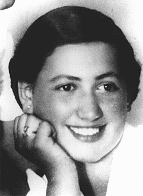
Ruth (Huppert) Elias
Born: October 6, 1922
Moravska Ostrava, Czechoslovakia
Ruth grew up in Moravska Ostrava, a city in the region of Moravia with the third-largest Jewish community in Czechoslovakia. When Ruth was a child her parents divorced. She and her sister, Edith, moved in with their paternal grandmother and then with their uncle, but they kept in close contact with their father. Ruth trained to be a pianist and hoped to attend a musical academy in Prague.
1933-39: In March 1939 Bohemia and Moravia were occupied by the Germans and declared a German protectorate. That fall, the city's Jewish males of working age were ordered to report for forced labor. Ruth's father escaped to his sister in Brno and arranged for Ruth and Edith to go to an aunt in the town of Vyskov. After a month he sent for his children and paid a Czech farmer to allow him and his daughters to work on a farm near Brno.
1940-45: In 1942 Ruth was deported to the Theresienstadt ghetto where she married. A year later, pregnant, she was deported to Auschwitz. After Ruth gave birth, an SS doctor ordered her breasts to be tied off with string as part of a medical experiment to see how long her baby daughter could live without food. Ruth secretly fed the baby by soaking pieces of bread in water, but the baby grew weak, her stomach swelling from hunger. A prisoner-doctor convinced Ruth to inject a lethal dose of morphine into the suffering baby, who had no chance of surviving.
Ruth was liberated by U.S. troops at a labor camp near Leipzig, Germany. After the war, she remarried and lived in Prague. In 1949 she immigrated to Israel.